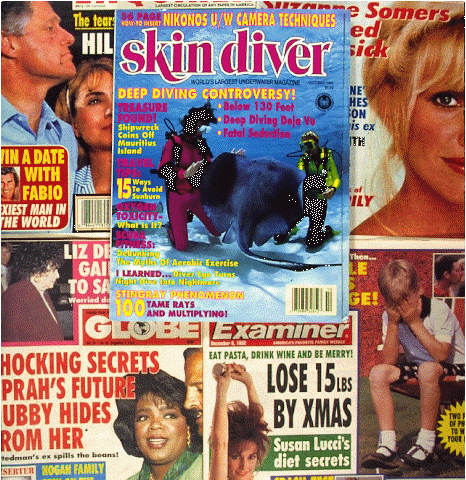
by
Larry "Harris" Taylor, Ph.D.
This material is copyrighted and
all rights retained by the author. This article is made available as a service
to the diving community by the author and may be distributed for any
non-commercial or Not-For-Profit use.
All rights reserved.
Go To: Home About "Harris" Articles War Stories Editorials Links Fini
Whenever there is an economic slump in the diving industry, there is a reflex introduction of new techniques or a lowering of training standards to increase the revenue-source population. Such was the case in the early 1990's. Some hailed the introduction of deep diving, oxygen-enriched air (called "Nitrox"), and rebreathers into the recreational diving community as being nothing short of miraculous ... something to "save the industry!" Others, who could could not participate in this increased revenue, saw things differently. Although the "save the industry" banner is a repeating phenomena, nothing, in my experience in the recreational diving community, has more polarized the training agencies than the introduction of oxygen enriched air.
I remember being excited at the time because many, myself included, believed (more like a fervent hope) that since these techniques required a higher level of understanding, that perhaps the training agencies would re-insert material (history, physics, physiology and in-water time necessary for in-water comfort) that had been removed (beginning in the late 1970's) from their basic training classes. Sadly, this did NOT occur.
What did happen was an hysteria-like response and a sharp division of the diving community. Articles and editorials appeared misrepresenting history, medicine and science far in excess of the usual practices in an attempt to discredit anything labeled "technical." The hype was so intense that some labeled Nitrox "the Devil's Gas." It was even claimed that using oxygen enriched air would prohibit chamber treatment of a diving accident should a decompression illness event occur. This misrepresentation of reality was the trigger for my "Bambi letter " that was published in several magazines and circulated on the 'net (The Bambi Letter). The claim that Nitrox was a new mix and as such, had not been around long enough to evaluate led to my article on EANx history ( Early EANx History). This history of Nitrox article was later expanded (A Brief History of Mixed Gas Diving). The rumor at the time (which I can not confirm or deny, but believe to be true) was that much of this anti-tech hysteria was fueled by the inability of some to obtain the required liability insurance to teach these techniques. (I do know that when a particular agency that was stating "Nitrox" had not yet been used enough to validate went into the insurance pool, my liability insurance jumped from $ 125 to $ 495.) Regardless of the reason, some recreational dive magazines of the time were at the forefront of the anti-tech movement.
The editorial pages and letters to the editor from the early 1990s of many popular recreational dive magazines document this campaign against technical diving, especially oxygen enriched air and diving below 130 fsw. The open hostility that is the hallmark of many scuba internet chat rooms and newsgroups of today is mild compared to the flames present in these groups in the '90's.when technical diving was argued (not discussed).
So, at the height of this "anti-Nitrox" campaign, I created the image below using 4 tabloid newspapers and the now-defunct Skin Diver magazine (which was then featuring a series of inflammatory editorials against all things "tech"). I made 37 copies (1 roll of 35 mm slide film) of the image and sent 35 of them to selected members of the tech diving community with my 1992 Christmas card along with a satirical comment about the slide containing my new gospel of diving.

The Slide
A few months later, I found out this slide has been published in a tech dive magazine without my knowledge, consent, or attribution. I also discovered that some of my "friends" who had received this slide were selling copies for their personal profit.
The points are:
1. Comments made in jest, in private, often find their way into the public sector. So, in the words of the the desk sergeant from the TV show Hill Street Blues, "Be careful out there."
2. Do not be surprised when you find your words or images being sold for some one else's profit. The practice of plagiarism for profit within the recreational community is far too common. It is often vehemently defended with a disproportionately high magnitude of malevolence.
3. While P. T. Barnum may have said "there is sucker born every minute," people, given time, do recognize the difference between hype and fact.
4. Greed driven smoke screens are the easiest defenses to debunk because they typically wander far from the path of established history, logic and scientific fact.
Go To: Home About "Harris" Articles War Stories Editorials Links Fini
About The Author:
Larry "Harris" Taylor, Ph.D. is a biochemist and Diving Safety Coordinator at the University of Michigan. He has authored more than 200 scuba related articles. His personal dive library (See Alert Diver, Mar/Apr, 1997, p. 54) is considered one of the best recreational sources of information In North America.
All rights reserved.
Use of these articles for personal or organizational profit is specifically denied.
These articles may be used for not-for-profit diving education